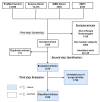A Systematic Survey of Research Trends in Technology Usage for Parkinson's Disease
- PMID: 35897995
- PMCID: PMC9371095
- DOI: 10.3390/s22155491
A Systematic Survey of Research Trends in Technology Usage for Parkinson's Disease
Abstract
Parkinson's disease (PD) is a neurological disorder with complicated and disabling motor and non-motor symptoms. The complexity of PD pathology is amplified due to its dependency on patient diaries and the neurologist's subjective assessment of clinical scales. A significant amount of recent research has explored new cost-effective and subjective assessment methods pertaining to PD symptoms to address this challenge. This article analyzes the application areas and use of mobile and wearable technology in PD research using the PRISMA methodology. Based on the published papers, we identify four significant fields of research: diagnosis, prognosis and monitoring, predicting response to treatment, and rehabilitation. Between January 2008 and December 2021, 31,718 articles were published in four databases: PubMed Central, Science Direct, IEEE Xplore, and MDPI. After removing unrelated articles, duplicate entries, non-English publications, and other articles that did not fulfill the selection criteria, we manually investigated 1559 articles in this review. Most of the articles (45%) were published during a recent four-year stretch (2018-2021), and 19% of the articles were published in 2021 alone. This trend reflects the research community's growing interest in assessing PD with wearable devices, particularly in the last four years of the period under study. We conclude that there is a substantial and steady growth in the use of mobile technology in the PD contexts. We share our automated script and the detailed results with the public, making the review reproducible for future publications.
Keywords: Parkinson’s disease; biopotential devices; diagnosis; digital health; prognosis; taxonomy; wearable devices.
Conflict of interest statement
The authors declare no conflict of interest.
Figures













Similar articles
-
Wearable Solutions for Patients with Parkinson's Disease and Neurocognitive Disorder: A Systematic Review.Sensors (Basel). 2020 May 9;20(9):2713. doi: 10.3390/s20092713. Sensors (Basel). 2020. PMID: 32397516 Free PMC article.
-
How Wearable Sensors Can Support Parkinson's Disease Diagnosis and Treatment: A Systematic Review.Front Neurosci. 2017 Oct 6;11:555. doi: 10.3389/fnins.2017.00555. eCollection 2017. Front Neurosci. 2017. PMID: 29056899 Free PMC article. Review.
-
Automated Systems Based on Wearable Sensors for the Management of Parkinson's Disease at Home: A Systematic Review.Telemed J E Health. 2019 Mar;25(3):167-183. doi: 10.1089/tmj.2018.0035. Epub 2018 Jul 3. Telemed J E Health. 2019. PMID: 29969384
-
Wearable Health Technology to Quantify the Functional Impact of Peripheral Neuropathy on Mobility in Parkinson's Disease: A Systematic Review.Sensors (Basel). 2020 Nov 19;20(22):6627. doi: 10.3390/s20226627. Sensors (Basel). 2020. PMID: 33228056 Free PMC article.
-
Wearable Sensors for Sleep Monitoring in Free-Living Environments: A Scoping Review on Parkinson's Disease.Biosensors (Basel). 2025 Mar 25;15(4):212. doi: 10.3390/bios15040212. Biosensors (Basel). 2025. PMID: 40277526 Free PMC article.
Cited by
-
Keystroke Biometrics as a Tool for the Early Diagnosis and Clinical Assessment of Parkinson's Disease.Diagnostics (Basel). 2023 Sep 26;13(19):3061. doi: 10.3390/diagnostics13193061. Diagnostics (Basel). 2023. PMID: 37835803 Free PMC article.
-
Evaluation of compliance and accuracy in Parkinson's disease motor symptom tracking: a comparative study of digital and traditional paper diaries using a smartphone application (MyParkinson's).Front Neurol. 2025 Jan 29;16:1522721. doi: 10.3389/fneur.2025.1522721. eCollection 2025. Front Neurol. 2025. PMID: 39944543 Free PMC article.
-
Modernizing the Staging of Parkinson Disease Using Digital Health Technology.J Med Internet Res. 2025 Apr 4;27:e63105. doi: 10.2196/63105. J Med Internet Res. 2025. PMID: 40184612 Free PMC article.
-
Malicious Activity Detection in Lightweight Wearable and IoT Devices Using Signal Stitching.Sensors (Basel). 2021 May 13;21(10):3408. doi: 10.3390/s21103408. Sensors (Basel). 2021. PMID: 34068359 Free PMC article.
-
The Parkinson's disease waiting room of the future: measurements, not magazines.Front Neurol. 2023 Aug 21;14:1212113. doi: 10.3389/fneur.2023.1212113. eCollection 2023. Front Neurol. 2023. PMID: 37670776 Free PMC article.
References
-
- The Parkinson’s Foundation Parkinson’s Foundation: Better Lives Together. [(accessed on 25 June 2022)]. Available online: https://bit.ly/2Uc6ikj.
-
- Harish K., Rao M.V., Borgohain R., Sairam A., Abhilash P. Tremor quantification and its measurements on parkinsonian patients; Proceedings of the 2009 International Conference on Biomedical and Pharmaceutical Engineering; Singapore. 2–4 December 2009; pp. 1–3.
-
- Contreras R., Huerta M., Sagbay G., LLumiguano C., Bravo M., Bermeo A., Clotet R., Soto A. Tremors quantification in parkinson patients using smartwatches; Proceedings of the 2016 IEEE Ecuador Technical Chapters Meeting (ETCM); Guayaquil, Ecuador. 12–14 October 2016; pp. 1–6.
-
- Jenkins M., Almeida Q., Spaulding S., Van Oostveen R., Holmes J., Johnson A.M., Perry S. Plantar cutaneous sensory stimulation improves single-limb support time, and EMG activation patterns among individuals with Parkinson’s disease. Park. Relat. Disord. 2009;15:697–702. doi: 10.1016/j.parkreldis.2009.04.004. - DOI - PubMed
Publication types
MeSH terms
Grants and funding
LinkOut - more resources
Full Text Sources
Medical

